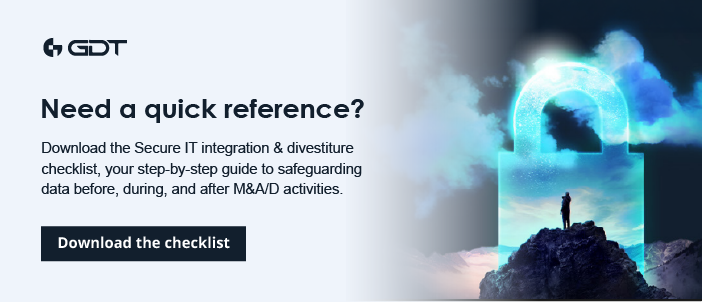Summary
- Mergers, acquisitions, and divestitures expand an organization’s cybersecurity exposure.
- Overlooking security during planning, integration, or post-transaction phases can lead to data breaches, compliance violations, and financial loss.
- Embedding cybersecurity into every stage—from due diligence to post-integration—safeguards sensitive information, helps ensure compliance, and strengthens resilience.
Mergers, acquisitions, and divestitures (M&A/D) offer opportunities for businesses to grow, streamline operations, and enter new markets. However, strategic planning and financial negotiations can overshadow a crucial element: information security.
This blog post dives into the critical security considerations for M&A/D activities, exploring the importance of information security, potential risks, and best practices to ensure a smooth and secure transaction.
Why does cybersecurity matter in M&A/D?
Information security is paramount during M&A/D for several reasons:
- Data sensitivity: M&A/D involves sharing confidential information like financial records, intellectual property (IP), and customer data.
- Breach risk: Security breaches can lead to financial losses, reputational damage, and legal repercussions.
- Integration complexity: Merging IT systems and security protocols can introduce vulnerabilities if not managed effectively. In fact, around 80% of all breaches involve a privileged account.1
Remember the Marriott-Starwood data breach? It highlights the potential consequences of lax cybersecurity during M&A/D.
Cybersecurity before, during, and after a merger and acquisition

Ensuring your data is secure and away from the hands of bad actors is not a single-stage process. There are key components to protecting vulnerable data at each phase of an M&A/D.
Pre-transaction security due diligence
Before finalizing any deal, thorough due diligence is essential to identify and mitigate security risks. Key areas to assess include:
- Network security: Evaluate firewalls, intrusion detection systems, and network architecture of both parties.
- Application security: Identify vulnerabilities in software applications and databases.
- Data security: Assess data classification, access controls, and encryption practices.
- Compliance: Verify adherence to relevant data privacy regulations (e.g., GDPR, CCPA, HIPAA, PCI).
Identifying security gaps early on allows for the development of a robust integration plan.
Protecting data during M&A/D
Handling sensitive data requires meticulous attention to data protection and privacy:
- Data classification: Implement a data classification framework to categorize and protect critical data.
- Compliance: Ensure adherence to data privacy regulations throughout the process.
- Secure data transfer: Use encryption and secure protocols for data transfer during migration.
Prioritizing data protection fosters trust and avoids regulatory issues.
Cybersecurity threats during M&A/D
M&A/D scenarios are vulnerable to various cybersecurity threats:
- Phishing attacks: Criminals may exploit communication channels to launch phishing attacks.
- Insider threats: Disgruntled or careless employees can pose significant risks.
- Malware and ransomware: Malicious software can disrupt operations and compromise data integrity.
The Yahoo-Verizon breach exemplifies the severity of cybersecurity threats during M&A/D, emphasizing the need for proactive security measures.
Integration challenges and security considerations
Post-transaction IT system integration presents several security challenges:
- Merging systems: Consolidate networks, applications, and data centers while maintaining strong security.
- Security policy harmonization: Develop unified security policies and procedures across the merged entity.
- Communication security: Ensure secure communication channels between the merging entities.
- Business continuity: Implement strategies to maintain operations during the transition.
Careful planning and execution are crucial to addressing these challenges and preventing security lapses.
Post-transaction security measures
Security vigilance remains vital even after the transaction closes:
- Continuous monitoring: Implement real-time threat detection and monitoring systems.
- Security protocol updates: Regularly update and unify security protocols across the new organization.
- Employee security training: Conduct training to enhance employee security awareness and compliance.
- Regular security audits: Perform regular security assessments to identify and mitigate evolving risks.
Ongoing vigilance helps maintain a secure environment and adapt to changing threats.
Legal and regulatory considerations
M&A/D activities are subject to various legal and regulatory requirements:
- Legal obligations: Understand and fulfill legal obligations related to data protection and security.
- Regulatory compliance: Ensure compliance with industry standards and regulations.
- Legal scrutiny: Be prepared for potential legal scrutiny in case of security incidents.
Navigating the legal landscape helps avoid penalties and ensures a smooth transaction.
Best practices for secure and successful M&A/Ds
Here are some best practices to ensure a secure M&A/D process:
- Comprehensive security strategy: Develop a detailed security strategy encompassing all aspects of the transaction.
- Security expertise: Engage with experienced information security professionals.
- Advanced security technologies: Leverage technologies like encryption, SIEM, and intrusion detection systems.
- Clear communication: Establish clear communication channels and define security responsibilities for all parties involved.
Implementing these best practices strengthens your overall security posture and facilitates a successful M&A/D process.
Conclusion
M&A/D presents exciting business opportunities, but neglecting information security can lead to devastating consequences. By proactively addressing the critical security considerations outlined in this post, companies can mitigate risks, protect sensitive data, and achieve a smooth and successful transaction. Proactive and strategic security planning is essential to safeguard the interests of all parties involved and to realize the desired outcomes of M&A/D activities.
For additional insights, be sure to download the Secure IT integration & divestiture checklist to help you uncover critical security considerations for data center resiliency during every phase of your M&A/D activities.
Key takeaways
- Start cybersecurity planning early on, well before the deal closes, to uncover hidden risks.
- Maintain strict data protection and compliance controls during migration and integration.
- Continue active monitoring, audits, and employee training after the transaction.
- Align policies, technology, and communication across both organizations to reduce vulnerabilities.
- Treat cybersecurity as a core business function throughout the M&A/D process, not a post-deal task.
- Deloitte, Beyond Numbers: Critical Role of Cybersecurity in M&A Deals – WSJ, found at: https://deloitte.wsj.com/riskandcompliance/beyond-numbers-critical-role-of-cybersecurity-in-m-a-deals-6aba020c?utm_source=chatgpt.com (accessed Oct. 28, 2025) ↩︎


